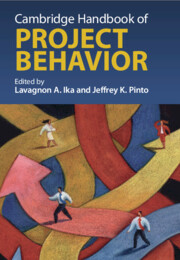Book contents
- Cambridge Handbook of Project Behavior
- Cambridge Handbook of Project Behavior
- Copyright page
- Contents
- Figures
- Tables
- Contributors
- Introduction
- Part I Guiding Principles
- Part II Deviating from Plans
- Part III Practical Tips
- Chapter 13 Setting Realistic Project Goals
- Chapter 14 At the Brink of a Project
- Chapter 15 The Roles of Governance Mechanisms to Manage Misbehaviors in the Project Front-End
- Chapter 16 Coping with Changes to the Plan
- Chapter 17 Project Behavior, Disruptions, and the Antifragility Spectrum
- Chapter 18 Curbing Cost Increases and Benefit Shortfalls
- Afterword
- Index
- References
Chapter 14 - At the Brink of a Project
Heuristics to Block Potential Project Disasters during the Early Project Opportunity Screening
from Part III - Practical Tips
Published online by Cambridge University Press: aN Invalid Date NaN
- Cambridge Handbook of Project Behavior
- Cambridge Handbook of Project Behavior
- Copyright page
- Contents
- Figures
- Tables
- Contributors
- Introduction
- Part I Guiding Principles
- Part II Deviating from Plans
- Part III Practical Tips
- Chapter 13 Setting Realistic Project Goals
- Chapter 14 At the Brink of a Project
- Chapter 15 The Roles of Governance Mechanisms to Manage Misbehaviors in the Project Front-End
- Chapter 16 Coping with Changes to the Plan
- Chapter 17 Project Behavior, Disruptions, and the Antifragility Spectrum
- Chapter 18 Curbing Cost Increases and Benefit Shortfalls
- Afterword
- Index
- References
Summary
Traditional project management literature often portrays heuristics as flawed shortcuts leading to errors, advocating for rational, debiasing strategies to prevent cost overruns and benefit shortfalls. This is problematic as heuristics can be effective. Building on Gigerenzer’s concept of fast-and-frugal heuristics, this study examines the use of such smart heuristics by senior managers in a large engineering consultancy firm during the early bid/no-bid decision-making phase of infrastructure projects. Employing a qualitative method from the naturalistic decision-making program, the research uncovers a decision strategy termed "thresholding." This strategy distills extensive experience and interpretation of ambiguous information into binary decisions, effectively de-selecting projects that could be potentially disastrous. The approach also gives credence to agency, as it only deselects disasters but keeps many potential alternatives in the portfolio to mature into potentially ‘good projects’. At the same time, it addresses Flyvbjerg’s call for some scrutiny at the front end of projects to avoid catastrophic projects that start on the wrong premises. Our chapter adds to the debate on the Hiding Hand by not being concerned with the “hidden”, but instead, with what can be known in the early fuzzy front-end of projects.
Information
- Type
- Chapter
- Information
- Cambridge Handbook of Project Behavior , pp. 216 - 232Publisher: Cambridge University PressPrint publication year: 2025
References
Accessibility standard: WCAG 2.0 A
Why this information is here
This section outlines the accessibility features of this content - including support for screen readers, full keyboard navigation and high-contrast display options. This may not be relevant for you.Accessibility Information
Content Navigation
Allows you to navigate directly to chapters, sections, or non‐text items through a linked table of contents, reducing the need for extensive scrolling.
Provides an interactive index, letting you go straight to where a term or subject appears in the text without manual searching.
Reading Order & Textual Equivalents
You will encounter all content (including footnotes, captions, etc.) in a clear, sequential flow, making it easier to follow with assistive tools like screen readers.
You get concise descriptions (for images, charts, or media clips), ensuring you do not miss crucial information when visual or audio elements are not accessible.
You get more than just short alt text: you have comprehensive text equivalents, transcripts, captions, or audio descriptions for substantial non‐text content, which is especially helpful for complex visuals or multimedia.
You can access graphs or charts in a text or tabular format, so you are not excluded if you cannot process visual displays.
Visual Accessibility
You will still understand key ideas or prompts without relying solely on colour, which is especially helpful if you have colour vision deficiencies.
You benefit from high‐contrast text, which improves legibility if you have low vision or if you are reading in less‐than‐ideal lighting conditions.
